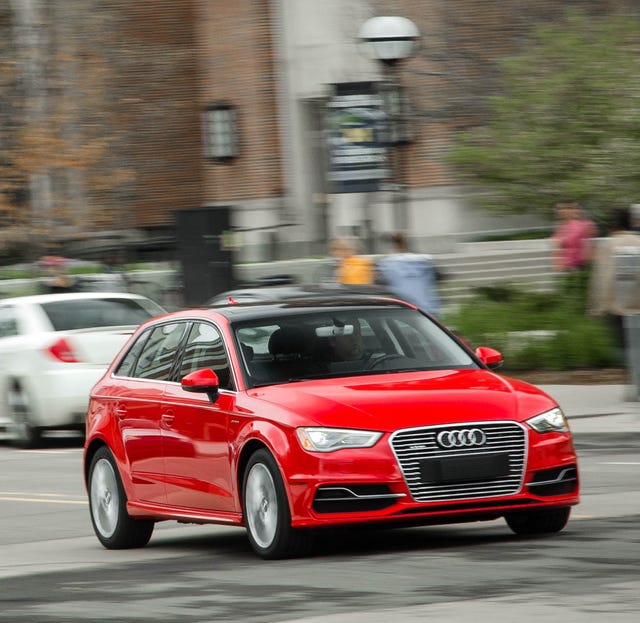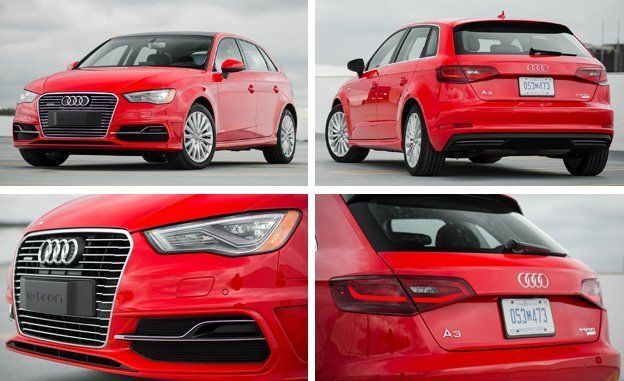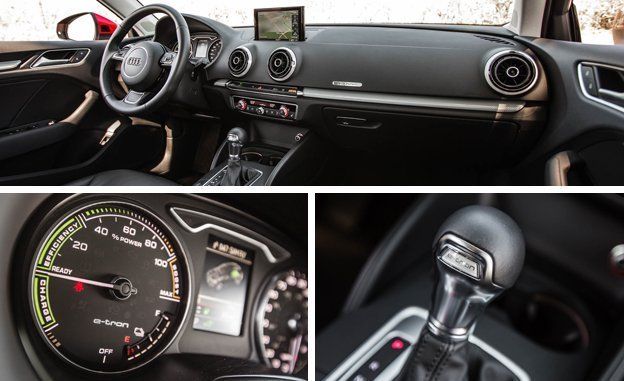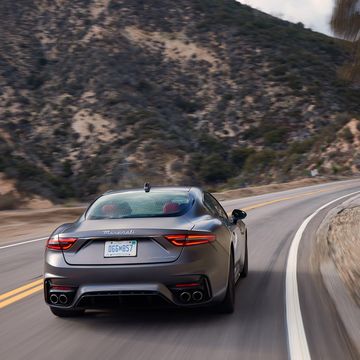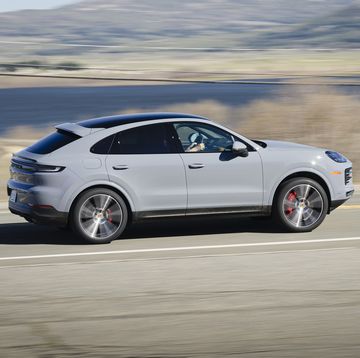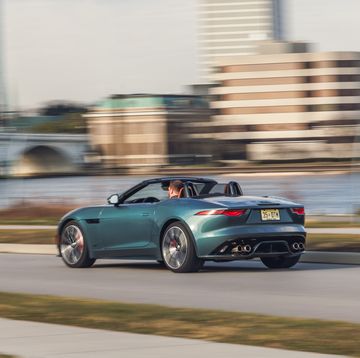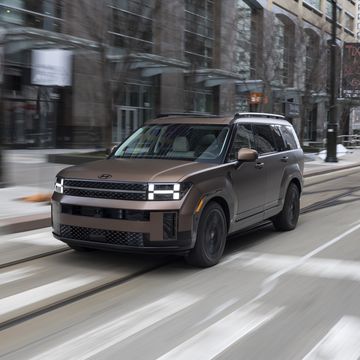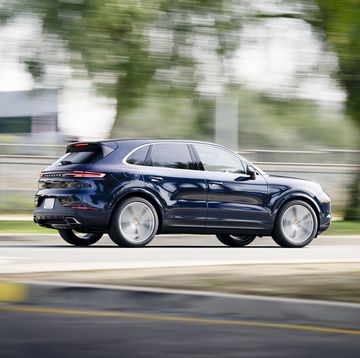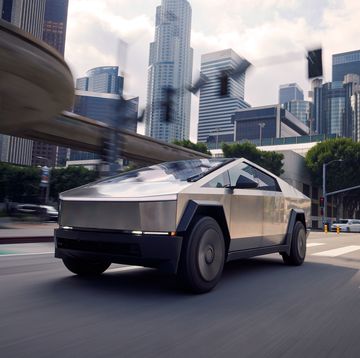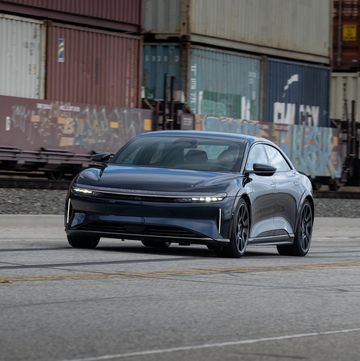It has been a decade since Al Gore hit the lecture circuit with his famed PowerPoint presentation/global-warming doomsday prophecy. In those 10 years, dozens of plug-in hybrids and electric vehicles have hit the market, promising ice-cap-friendly emissions and eliciting barely a glance from mainstream America (with one notable exception; hats off, Mr. Musk). Undeterred, Audi has a new entrant in this race that it hopes will be enough to tempt fuel-conscious customers who, in less scandalous times, might have shopped for a diesel from Germany.
Not Your Average Audi
That vehicle is the 2016 Audi A3 Sportback e-tron tested here. It’s among the first in what soon will become a herd of luxury or near-luxury plug-in hybrids—look for the Mercedes-Benz C350e and the BMW 330e this year and several new Volvo PHEV models before the end of the decade. Compared with more familiar plug-ins such as the Chevrolet Volt and the Ford C-Max Energi, the Audi feels more upscale. Real leather seating surfaces come standard even on Audi’s base Premium trim level, and the A3 boasts solid driving dynamics. Nor does the A3 shout its environmentalist credentials; it lacks the cliché blue trim, and its charging-plug port is hidden behind the rings on the grille. One easily could mistake the e-tron for a regular A3.
But it’s quite a bit more than that. For one thing, the e-tron is the only A3 hatchback currently for sale in the United States. More important, there’s the hybrid powertrain. An 8.8-kWh battery tucked underneath the rear seats powers a 102-hp electric motor that also makes 243 lb-ft of torque. Add the e-tron’s 150-hp 1.4-liter turbocharged four-cylinder engine to the mix, and the total system output is 204 horsepower and 258 lb-ft.
Choices, Choices
The e-tron has four driving modes to maximize the efficiency of that powertrain: EV, Hybrid, Hold, and Charge. Thoughtful drivers can switch among them to modulate the e-tron’s use of electric power. For example, on a commute that starts with highway miles and ends with city traffic, the driver can choose Hold mode to avoid using battery power during highway cruising, where EVs are less efficient. On long road trips, drivers can direct engine power to recharge a depleted battery, offering the opportunity to drive under battery power later without stopping to plug in. In EV mode, the A3 uses only the electric motor (unless the driver demands maximum power by pushing the accelerator past its built-in kickdown switch, at which point the gasoline engine turns on to provide additional thrust). Once the battery is emptied, the e-tron defaults to hybrid mode, where the propulsion is a blending together of both power sources, although even in this mode the electric hardware is still often used solely to power the car at low speeds and at stoplights.
Modes are selected using the Audi MMI infotainment and navigation system, which, despite some menu logic that we found questionable, is fairly user-friendly. It’s standard on the top Premium Plus, a $2100-to-$2600 option on Premium and Prestige trims. Sport mode, selected using the shift lever, maximizes the available power from both the gasoline engine and the electric motor.
But do all of those modes and options translate to savings at the pump? The A3 e-tron’s EPA ratings are 83 MPGe using only the electric motor and 35 mpg when the gasoline engine is in use. The Ultra version, a no-cost option that puts the car on low-rolling-resistance tires mounted on 16-inch wheels rather than the standard 17s on our test example, does slightly better, with EPA ratings of 86 MPGe using battery power and 39 mpg with the gasoline engine. Tallying both gallons of gas consumed and kilowatt-hours of electricity sucked out of the battery, we saw 40 MPGe combined during our nearly 600-mile test. And we likely could have done better, but the A3 went more than 150 miles without recharging on a weekend trip during our test.
That fuel-economy result doesn’t seem very impressive for a plug-in hybrid, and the e-tron’s electric range isn’t at the top of the heap, either. But in our experience, the battery delivered about 20 miles of EV range on a full charge, which is actually better than the EPA-estimated 17 miles.
By comparison, the Hyundai Sonata plug-in hybrid is rated at 27 miles of electric range, and the 2017 Chevrolet Volt is estimated to go a whopping 53 miles solely on battery power. Both of those vehicles have base prices several thousand dollars less than the e-tron’s $38,825 cost of entry. For drivers concerned only with fuel economy and electric range, the e-tron is not the best bang for their buck. But factor in its other abilities, and the A3 is a more complete package than much of its plug-in competition.
A Sporty Hybrid?
Those abilities were on display when we took the A3 to the test track. There, the e-tron recorded a respectable 6.5-second zero-to-60-mph run while fully charged. In EV mode—again fully charged—powered only by the battery and electric motor, the e-tron took nearly double that time to reach 60 mph: 11.2 seconds. Braking to a stop from 70 mph took 168 feet, with no fade after multiple efforts, and the e-tron delivered 0.85 g of lateral grip on the skidpad. By virtually every performance measure, it beats the Chevy Volt, the Ford C-Max Energi, and the BMW i3. (The i3 stopped eight feet shorter, but it’s more than 500 pounds lighter than the A3 e-tron.)
On public roads, the A3 feels quick, predictable, and solid. Despite the hybrid powertrain’s extra weight (the e-tron is 478 pounds heavier than the most recent A3 1.8T sedan we tested), the e-tron delivers drama-free highway passing.
Cargo space, another area where vehicular battery packs can exact a toll, is actually better in the A3 e-tron than in the A3 sedan, thanks to the hatchback body style. The e-tron’s 14 cubic feet is not the best in the plug-in class—Ford’s C-Max Energi boasts 19 cubes behind the second row—but it was enough to haul daily detritus with room to spare.
Audi is hoping that for the right customer, the e-tron’s stylish exterior, luxury touches, and good road manners will be enough to justify its steep price. The sleek Sportback is practically designed to make the neighbors jealous, especially in our test car’s Misano Red paint (a $575 option). Inside, the Premium Plus package on the model we tested ($4100) added heated front seats, LED headlights, Audi’s iPod interface, and other cosmetic improvements. The $2600 Technology package upgrades the MMI system to include a touchpad on the control wheel for fingertip inputs, as well as adding 4G internet connectivity and blind-spot monitoring. For an even sportier experience, drivers can opt for the $1150 Sport package (which our car didn’t have); it adds extendable thigh supports on the front seats, shift paddles, 18-inch wheels, and more leather in the cabin. In all, our test car totaled $46,100.
All those amenities vaulted our loaded A3 into a price point somewhere between mass-market plug-ins like the Volt and the C-Max and larger luxury plug-ins like the Mercedes-Benz C350e and the BMW 330e. For a practical buyer, a less expensive PHEV with more all-electric range would be a wiser choice. The e-tron is designed for a very specific customer: one who typically drives only short distances (the better to minimize using the gasoline engine), cares at least as much about appearances as about reduced emissions, and is willing to pay a premium for luxury cachet. For someone with that unusual blend of priorities, the A3 e-tron is one of the best transportation solutions this side of the BMW i8.
Specifications

Annie White has been writing and editing for Car and Driver since 2016. She has owned two Chevrolet HHRs. It was a mistake both times.
